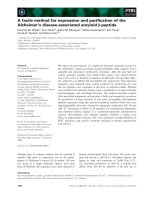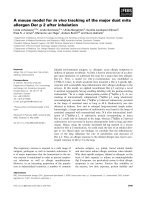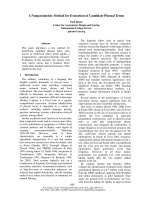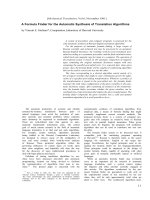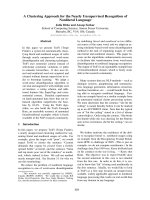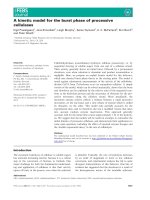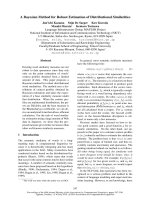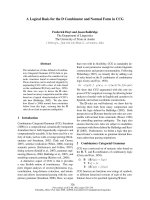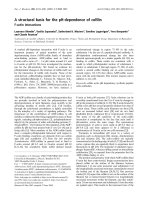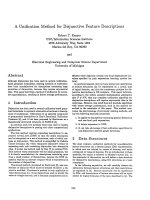Báo cáo sinh học: " A tree-based method for the rapid screening of chemical fingerprints" potx
Bạn đang xem bản rút gọn của tài liệu. Xem và tải ngay bản đầy đủ của tài liệu tại đây (551.84 KB, 10 trang )
RESEA R C H Open Access
A tree-based method for the rapid screening of
chemical fingerprints
Thomas G Kristensen
*
, Jesper Nielsen
*
, Christian NS Pedersen
Abstract
Background: The fingerprint of a molecule is a bitstring based on its structure, constructed such that structurally
similar molecules will have similar fingerprints. Molecular fingerprints can be used in an initial phase of drug
development for identifying novel drug candidates by screening large databases for molecules with fingerprints
similar to a query fingerprint.
Results: In this paper, we present a method which efficiently finds all fingerprints in a database with Tanimoto
coefficient to the query fingerprint above a user defined threshold. The method is based on two novel data
structures for rapid screening of large databases: the kD grid and the Multibit tree. The kD grid is based on
splitting the fingerprints into k shorter bitstrings and utilising these to compute bounds on the similarity of the
complete bitstrings. The Multibit tree uses hierarchical clustering and similarity within each cluster to compute
similar bounds. We have implemented our method and tested it on a large real-world data set. Our experiments
show that our method yields approximately a three-fold speed-up over previous methods.
Conclusions: Using the novel kD grid and Multibit tree significantly reduce the time needed for searching
databases of fingerprints. This will allow researchers to (1) perform more searches than previously possible and (2)
to easily search large databases.
1 Introduction
When developing novel drugs, researchers are faced
with the task of selecting a subset of all commercially
available molecules for further experiments. There are
more than 8 million such molecules available [1], and it
is not feasible to perform computationally expensive cal-
culations on each one. Therefore, the need arises for
fast screening methods for identifying the molecules
that are most likely to have an effect on a given disease.
It is often the case that a molecule with some effect i s
already known, e.g. from an already existing drug. An
obvious initial screening method presents itself, namely
to identify the molecules which are similar to this
known molecule. To implement this screening method
one must decide on a representation of the molecules
and a similarity measure between representations of
molecules. Several representations and similarity mea-
sures have been proposed [2-4]. We focus on molecular
fingerprints. A fingerprint for a given molecule is a
bitstring of size N which summarises structural informa-
tion about the molecule [3]. Fingerprints should be con-
structed such that if two fingerprints are very similar, so
are the molecules which they represent. There are sev-
eral ways of measuring the similarity between finger-
prints [4]. We focus on the Tanimoto coefficient,which
is a normalised measure of how many bits two finger-
prints share. It is 1.0 when the finger prints are the
same, and strictly smaller than 1.0 whe n they a re not.
Molecular fingerprints in combination with the Tani-
moto coefficient have been used successfully in previous
studies [5].
We focus on the screening problem of finding all fin-
gerprints in a database with Tanimoto coefficient t o a
queryfingerprintaboveagiventhreshold,e.g.0.9.Pre-
vious attempts have been made to improve the query
time. One approach is to reduce the number of finger-
prints in the database for which the Tanimoto coeffi-
cient to the query fingerprint has to be computed
explicitly. This includes storing the fingerprints in the
database in a vector of bins [6], or in a trie like structure
[7], such that searching certain bins, or parts of the trie,
* Correspondence: ;
Bioinformatics Research Center (BiRC), Aarhus University, CF Møllers Allé 8,
DK-8000 Århus C, Denmark
Kristensen et al. Algorithms for Molecular Biology 2010, 5:9
/>© 2010 Kristensen et al; licensee BioMed Central Ltd. This is an Open Access article distributed under the terms of the Creative
Commons Attr ibution License (http ://creativecommons.org/licenses/b y/2.0), which permits unrestricted use, distri bution, and
reproduction in any medium, provided the original work is properly cited.
can be avoided based on an upper-bound on the Tani-
moto coefficient between the query fingerprint and all
fingerprints in individual bins or subtries. Another
approach is to store an XOR summary, i.e. a shorter bit-
string, of each fingerprint in the database, and use these
as rough upper bounds on the maximal Tanimoto coef-
ficients achievable, before calculating the exact coeffi-
cients [8].
In this paper, we present an efficient method for the
screening problem, which is based on an extension of
an upper bound given in [6] and two novel tree based
data structures for storing and retrieving fingerprints.
To further reduce the query time we also utilise the
XOR summary strategy [8]. We have implemented our
method and tested it on a realistic data set. Our experi-
ments clearly demonstrate that it is su perior to previou s
strategies, as it yields a three-fold speed-up over the pre-
vious best method.
2 Methods
A fingerprint is a bitstring of length N.LetA and B be
bitstrings, and let |A| denote the number of 1-bits in A.
Let A ∧ B denote th e logical and of A and B ,thatis,A
∧ B is the bitstring that has 1-bits in exactly those posi-
tions where both A and B do. Likewise, let A ∨ B denote
the logical or of A and B,thatis,A ∨ B is the bitstring
that has 1-bits in exactly those positions where either A
or B do. With this notation the Tanimoto coefficient
becomes:
SAB
AB
AB
T
(,) .
Figure 1 shows an example the usage of this notation.
In the following, we present a method for finding all fin-
gerprints B in a database of fingerprints with a Tani-
moto coefficient above some query-specific threshold
S
min
to a query fingerprint A. The method is based on
two novel data structures, the kDgridandtheMultibit
tree, for storing the database of fingerprints.
2.1 kD grid
Swamidass et al.showedin[6]thatif|A|and|B|are
known, S
T
(A, B) can be upper-bounded by
S
AB
AB
max
min(| |,| |)
max(| |,| |)
.
This bound can be used to speed up the search, by
storing the database of fingerprints in N +1buckets
such that bitstring B is stored in the |B|th bucket.
When searching for bitstrings similar to a query bit-
string A it is sufficient to examine the buckets where
S
max
≥ S
min
.
We have generalised this strategy. Select a number of
dimensions k and split the bitstrings into k equally sized
fragments such that
AAA A
BBB B
k
k
12
12
,
where X·Y is the concatenation of bitstrings X and Y .
The values |A
1
|, |A
2
|, , | A
k
|and|B
1
|, |B
2
|, , |B
k
|
can be used to obtain a tighter bound than S
max
.LetN
i
Figure 1 Example calculation of Tanimoto coefficient.Example
of calculation of the Tanimoto coefficient S
T
(A, B), where A =
101101 and B = 110100.
Figure 2 3D grid.ExampleofakD-grid with k =3.B is split into
smaller substrings and the count of 1-bits in each determines
where in B is placed in the grid. The small inner cube shows the
placement of B.
Kristensen et al. Algorithms for Molecular Biology 2010, 5:9
/>Page 2 of 10
be the length of A
i
and B
i
.ThekDgridisak-dim en-
sional cube of size (N
1
+1)×(N
2
+1)× ×(N
k
+1).
Each grid point is a bucket and the fingerprint B is
stored in the bucket at coordinates (n
1
, n
2
, , n
k
), where
n
i
=|B
i
|. An exampl e of such a grid is illust rated in Fig.
2. By comparing the partial coordinates (n
1
, n
2
, ,n
i
)of
a given bucket to |A
1
|, |A
2
|, , |A
i
|, where i ≤ k,itis
possible to upper-bound the Tanimoto coefficient
between A and every B in that bucket. By looking at the
partial coordinates (n
1
, n
2
, , n
i-1
), we can use this to
quickly identify those partial coordinates (n
1
, n
2
, ,n
i
)
that may contain fingerprints B with a Tanimoto coeffi-
cient above S
min
.
Assume the algorithm is visiting a partial coordinate
at level i i n the data structure. The indices n
1
, n
2
, , n
i-
1
are known, but we need to compute which n
i
to visit
at this level. The entries to be visited further down the
data structure n
i+1
, ,n
k
are, of course, unknown at
this point. A bound can be calculated in the following
manner.
SAB
AB
AB
A
j
B
j
j
k
A
j
B
j
j
k
A
j
n
j
j
k
T
(,)
min(| |, )
max(|
1
1
1
AA
j
n
j
j
k
A
j
n
j
A
i
n
i
j
i
A
j
n
j
|, )
min(| |, ) min(| |, ) min(| |,
1
1
1
))
max(| |, ) max(| |, ) max(| |, )
ji
k
A
j
n
j
A
i
n
i
j
i
A
j
n
j
ji
1
1
1
11
1
1
1
k
A
j
n
j
A
i
n
i
j
i
A
j
ji
k
A
j
min(| |, ) min(| |, ) | |
max(| |,
nn
j
A
i
n
i
j
i
A
j
ji
k
S
)max(| |, ) | |
max
1
1
1
grid
The n
i
s to visit lie in an interval and it is thus suffi-
cient to compute the upper and lower indices of this
interval, n
u
and n
l
respectively. Setting
SS
min max
grid
, iso-
lating n
i
and ensuring that the result is an integer in the
range 0 N
i
gives:
nSAAAAA
lii
i
i
i
max ( | | ) ( ) ,
min
max
||
min
||
0
and
n
A
i
A
i
A
i
SA
i
A
i
S
N
ui
min
min
||
||
min
(
max
||
)
min
,
where
AAn
ijj
j
i
min
min(| |, )
1
1
is a bound on the
number of 1-bits in the logical and in the first part of
the bitstrings.
AAn
ijj
j
i
max
max(| |, )
1
1
is a bound
for the logical or in the first part of the bitstrings.
Similarly,
AA
i
j
ji
k
||
||
1
is a bound on the last
part.
Note that in the case where k = 1 this datastructure
simply becomes the list presented by Swamidass et al.
[6], and in the case where k = N the datastructure
becomes the binary trie presented by Smellie [7]. We
have implemented the kD grid as a list of lists, where
any list containing no fingerprints is omitted. See Fig. 3
for an example of a 4D grid containing four bitstrings.
The fingerprints stored in a single bucket in the kD grid
can be organised in a number of ways. The most naive
approach is to store them in a simple list which has to
be searched linearly. We propose to store them in tree
structures as explained below.
2.2 Singlebit tree
The Singlebit tree is a binary tree which stores the fin-
gerprints of a single bucket from a kD grid. At each
node in the tree a position in the bitstring is chosen.
All fingerprints with a zero at that position are stored
intheleftsubtreewhileallthosewithaonearestored
in the right subtree. This division is continued recur-
sively until all the fingerprints in a given node are the
same. When searching for a query bitstring A in the
tree it now becomes possible, by comparing A to the
path from the root of the tree to a given node, to
compute an upper bound
S
max
single
on S
T
(A, B)for
every fingerprint B in the subtree of that given node.
Given two bitstring A and B let M
ij
be the number of
positions where A has an i and B has a j.Thereare
four po ssible combinations of i an d j,namelyM
00
,
M
01
, M
10
and M
11
.
The path from the root of a tree to a node defines
lower limits m
ij
on M
ij
for every fingerprint in the sub-
tree of that node. Let u
ij
denote the unknown difference
between M
ij
and m
ij
, that is u
ij
= M
ij
- m
ij
.
Remember that
||Bn
k
i
k
1
is known when proces-
sing a given bucket.
By using
uu Amm
uu Bmm
uuuu
10 11 10 11
01 11 01 11
11 01 11 10
||
||
min( , uu
uuu uuuu
11
01 10 11 01 11 10 11
)
max( , )
Kristensen et al. Algorithms for Molecular Biology 2010, 5:9
/>Page 3 of 10
an upper bound on the Tanimoto coefficient of any
fingerprint B in the subtree can then be calculated as
SAB
M
MMM
mu
mumumu
m
T
(,)
11
01 10 11
11 11
01 01 10 10 11 11
11
mmin( , )
max( , )
min(
uuuu
mmm uuuu
01 11 10 11
01 10 11 01 11 10 11
||| ,|| )
max(| | ,| | )
.
max
Am Bm
mm AmBm
S
10 01
01 10 10 01
single
When building the tree data structure it is not imme-
diately obvious how best to choose which bit positions
to split the data on , at a given node. The implemented
approach is to go through all the children of the node
and choose the bit which best splits them into two parts
of equal size, in the hope that this creates a well-
balanced tree. It should be note d that the tree struct ure
that gives the best search time is not necessarily a well-
balanced tree. Figure 4 shows an example of a Singlebit
tree.
The Singlebit tree can also be used to store all the fin-
gerprints in the database without a kD grid. In this case,
however, |B| is no longer available and thus the
S
max
single
bound cannot be used. A less tight bound can be
Figure 3 4D grid. Example of a 4D grid containing four bitstrings, stored as in our implementation. The dotted lines indicate the splits between
B
i
and B
i+1
.
Figure 4 Singlebit tree. Example of a Singlebit tree. The black squares mark the bits chosen for the given node, while the grey squares mark
bits chosen at an ancestor. The grey triangles represent subtrees omitted to keep this example simple. Assume we are searching for the
bitstring A in the example. When examining the node marked by the arrow we have the knowledge shown in B
?
about all children of that
node. Comparing A against B
?
gives us m
00
=0,m
01
=0,m
10
= 1 and m
11
= 2. Thus
S
max
single
4
5
. Indeed we find that S
T
(A, B)=
3
7
and S
T
(A,
B’)=
4
6
.
Kristensen et al. Algorithms for Molecular Biology 2010, 5:9
/>Page 4 of 10
formulated, but experiments, not included in this paper,
indicate that this is a poor strategy.
2.3 Multibit tree
The experiments in Sec. 3 unfortunately show that using
the kD grid combined with Singlebit trees decreases per-
formance compared to using the kDgridandsimple
lists. The fingerprints used in our experiments have a
length of 1024 bits. In our experiments no Singlebit tree
was observed to contain more the 40,000 fingerprints.
This implies that the expected height of the Singlebit
trees is no more than 15 (as we aim for balanced trees
cf. above). Consequently, the algorithm will only obtain
information about 15 out of 1024 bits before reaching
the fingerprints. A strategy for obtaining more informa-
tion is to store a list of bit positions, along with an
annotation of whether each bit is zero or one, in each
node. The bits in this list are called the match-bits.
The Multibit tree is an extension of the Singlebit tree,
where we no longer demand that all children of a given
node are split according to the value of a single bit. In
fact we only demand that the data is arranged in some
binary tree. The match-bits of a given node are com-
puted as all bits that are not a match-bit in any ancestor
and for which all fingerprints in the leaves of the node
have the same value. Note that a node could easily have
no match-bits. When searching through the Multibit
tree, the query bitstring A is compared to the match-
bits of each visited node and m
00
, m
01
, m
10
and m
11
are
updated accordingly.
S
max
multi
is computed the same way
as
S
max
single
and only branches for which
S
max
multi
≥ S
min
are
visited.
Again, the best way to build the tree is not obvious.
Currently, the same method as for the Singlebit trees is
used. For a node with a given set of fingerprin ts, choose
the bit which has a 1-bit in, as close as possible to, half
of the fingerprints. Split the fingerprints into two sets,
based on the state of the chosen bit in each fingerprint.
Continue recursively in the two children of the node.
Figure 5 shows an example of a Multibit tree. To reduce
the memory consumption of the inner nodes, the split-
ting is stopped and leaves created, for any node that has
less than some limit l children. Based on initial experi-
ments, not included in this paper, l is chosen as 6,
which reduces memory consumption by more than a
factor of two and has no significant impact on speed.
An obvious alternative way to build the tree would be
to base it on some hierarchical clustering method, such
as Neighbour Joining [9].
3 Experiments
We have impl emented the kD grid and the Single- and
Multibit tree in Java. The implementation along with all
test data is available a t />motoQuery/.
Using these implementations, we have constructed
several search methods corresponding to the different
combinations of the data structures. We have examined
the k Dgridfork = 1, 2, 3 and 4, where the fingerprints
in the buckets are stored in a simple list, a Singlebit tree
or a Multibit tree. For purposes of comparison, we have
impl emented a linear search strategy, that simply exam-
ines all fingerprints in the database. We have also
Figure 5 Multibit tree. An example of a Multibit tree. The black squares marks the match-bits and their annotation. Grey squares show bits that
were match-bits at an ancestor. Grey triangles are subtrees omitted to keep this example simple. When visiting the node marked by the arrow
we get m
00
=1,m
01
=1,m
10
= 1 and m
11
= 2, thus
S
max
multi
4
6
. Still S
T
(A, B)=
3
7
and S
T
(A, B’)=
4
6
.
Kristensen et al. Algorithms for Molecular Biology 2010, 5:9
/>Page 5 of 10
implemented the strategy of “pruning using the bit-
bound approach first, followed by pruning using the dif-
ference of the number of 1-bits in the XOR-compressed
vectors, followed by pruning using the XOR approach”
from [8]. This strategy will hereafter simply be known
as Baldi. A trick of comparing the XOR-folded bit-
strings [8] immediately before computing the true Tani-
moto coefficient, is us ed in all our strategies to impro ve
performance. The length of the XOR summary is set to
128, as suggested in [8]. An experiment, not included in
this paper, confirmed that this is indeed the optimal size
of the XOR fingerprint. We have chosen to reimplement
related methods in order to make an unbiased compari-
sion of the running times independent of programming
language differences.
The methods are tested on a real-world data set by
downloading version 8 of the ZINC database [1], con-
sisting of roughly 8.5 million commercially available
molecules. Note that only 2 million of the molecules
have actually been used, due to memory constraints.
Figure 6 Distribution of number of bits in fingerprints. Distribution of the number of bits set in the 1024 bit CDK fingerprints from the ZINC
database.
Figure 7 Average query time, different database size. Different strategies tested with k = 1, , 4. Each experiment is performed 100 times,
and the average query time is presented. All experiments are performed with a S
min
of 0.9. The three graphs (a) - (c) show the performance of
the three bucket types for the different values of k. The best k for each method is presented in graph (d) along with the simple linear search
results and Baldi.
Kristensen et al. Algorithms for Molecular Biology 2010, 5:9
/>Page 6 of 10
The distribution of one-bits is presented in Fig. 6, where
itcanbeseentherearemanybucketsinthe1Dgrid
that will be empty.
The experiments were performed on an Intel Core 2
Duo running at 2.5 GHz and with 2 GB of RAM. Fin-
gerprints were generated using the CDK fingerprint gen-
erator [10] which has a standard fingerprint size N of
1024. One molecule timed out and did not generate a
fingerprint. We have performed our tests on different
sizes of the data set, from 100,000 to 2,000,000 finger-
prints in 100,000 increments. For each data set size, the
entire data structure is created. Next, the first 100 fin-
gerprint s in the datab ase are used for queries. We mea-
sure the query time and the space consumption.
4 Results
Figure7showstheaveragequerytimeforthedifferent
strategies and different values of k plotted against the
database size. We note that the Multibit tree in a 1D grid
is best for all sizes. Surprisingly, the simple list, for an
appropriately high value of k,isfasterthantheSinglebit
tree, yet slower than the Multibit tree. This is probably
due to the fact that the Singlebit trees are too small to
contain sufficient inf ormation for an efficient pruning:
Figure 8 Average query time on lists, different k. Experiments with simple lists for k = 1, , 10 Each test is performed 100 times, and the
average query time is presented. All experiments are performed with a S
min
of 0.9. Missing data points are from runswith insufficient memory.
Figure 9 Average space consumption, different database size. The memory consumption of the data structure for different strategies tested
with k = 1, , 4. The three graphs (a) - (c) show the performance of the three bucket types for the different values of k. The k yielding the
fastest query time for each method is presented in graph (d) along with the simple linear search results and Baldi.
Kristensen et al. Algorithms for Molecular Biology 2010, 5:9
/>Page 7 of 10
the entire tree is t raversed, which is slower than traver-
sing the corresponding list i mplementation. All three
approaches (List, Singlebit- and Multibit trees) are clearly
superior to the Baldi approach, which in turn is better
than a simple linear search (with the XOR folding trick).
From Fig. 7a we notice that the List strategy seems to
become faster for increasing k. This trend is further
investigated in Fig. 8, which indicate that a k of three or
four seems optimal. As k grows the grid becomes larger
and more time consuming to traverse while the lists in
the buckets become shorter. For sufficiently large values
of k, the time spent pruning buckets exceeds the time
visiting b uckets containing superfluous fingerprints. The
Singlebit tree data in Fig. 7b indicates that the optimal
value of k is three. It seems the trees become too small
to contain enough information for an eff icient pruning,
when k reaches four. In Fig. 7c we see the Multibit tree.
Again, a too large k will actually slow down the data
Figure 10 Average query time, different thres hold. The best strategies from Fig. 7 tested for different values of S
min
. All experiments are
performed 100 times, with 2,000,000 fingerprints in the database, and the average query time is presented.
Figure 11 Fraction of coefficients calculated, different database size. The fraction of the database for which the Tanimoto coefficient is
calculated explicitly, measured for different number of fingerprints. The Tanimoto threshold is kept at 0.9.
Kristensen et al. Algorithms for Molecular Biology 2010, 5:9
/>Page 8 of 10
structure. This can be explained with arguments similar
to those for the Singleb it tree . Surprisingly, it seems a k
as low as one is optimal.
Figure 9 shows the memory usage per finger print as a
function of the number of loaded fingerprints. The first
thing we note is that the Multibit tree uses significantly
more memory than the other strategies. This is due to
the need to store a variable number of match-bits in
each node. The second thing to note is the space usage
for different k ’ s. In the worst case, where all buckets
contain fingerprints, the memory consumption per fin-
gerprint, for the grid alone, becomes
1
n
N
k
k
,
where n is the number of fingerprints in the database.
Thus we are not surprised by our actual results.
Figure 10 shows the se arch time as a function of the
Tanimoto threshold. In general we note that the simpler
and more naive data structures performs better for a
low Tanimoto threshold. This is due to the fact that, for
a low Tanimoto threshold a large part of the entire
database will be returned. In these cases very little prun-
ing can be done, and it is faster to run through a simple
list than to traverse a tree and compare bits at each
node. Of course we should remember that we are inter-
ested in performing searches for similar molecules,
which means large Tanimoto thresholds.
The reason why linear searc h is not constant time for
a constant data set is that, while it will always visit all
fingerprints, the time for visiting a given fingerprint is
not constant due to the XOR folding trick.
The running times of the different methods depend on
the number of T animoto coef ficients between pairs of
bitstrings that must be calculated explicitely. This num-
ber depends on the method and not on the programming
language in which the method is implemented, and is
thus an implementation independent performance mea-
sure. Figure 11 presents the fraction of coefficient calcu-
lated for varying number of fingerprints and a Tanimoto
threshold of 0.9. Each method seems to calculate a fairly
constant fraction of the fingerprints: only the Multibit
tree seems to vary with the number of fingerprints. This
is most likely due to the fact that more fingerprints result
in larger trees with more information.
The result is consistent with the execution time
experiments: the methods have the same relative r ank-
ing when measuring t he fraction of coefficients calcu-
lated as when measuring the average query time in Fig.
7. The fraction of coefficients calculated has also been
measured for varying Tanimoto thresholds with
2,000,000 fingerprints. The result is presented in Fig. 12.
It seems that the relation between the methods is con-
sistent across Tanimoto thresholds. Surprisingly, the
Multibit tree seems to reduce the fraction of fingerprints
for which the Tanimoto threshold has to be calculated
even for small values of the Tanimoto threshold: the
three other methods seem to perform very similar up
till a threshold of 0.8, whereas the Multibit tree seems
to differentiate itself at a threshold as low as 0.2.
The results seems to be consistent with the average
query time presented in Fig. 10.
5 Conclusion
In this paper we have presented a method for finding all
fingerprints in a database with Tanimoto coefficient to a
Figure 12 Fraction of coefficient calculated, different t hreshold. The fraction of the database for which the Tanimoto coefficient is
calculated explicitly, measured for a varying Tanimoto threshold and 2,000,000 fingerprints.
Kristensen et al. Algorithms for Molecular Biology 2010, 5:9
/>Page 9 of 10
query fingerprint above a user defined threshold. Our
method is based on a generalisation of the bounds
developed in [6] to multiple dimensions. Our generalisa-
tion results in a tighter bound, and experiments indicate
that this results in a performance increase. Furthermore,
we have examined the possibility of utilising trees as
secondary data structures in the buckets. Again, our
experiments clearly demonstrate that this leads to a sig-
nificant performance increase.
Our methods allow researchers to search larger data-
bases faster than previously possible. The use of larger
databases should increase the likelihood of finding rele-
vant matches. The faster query times decreases the
effort and time needed to do a search. This allow more
searches to be done, either for more molecules or with
different thresholds S
min
on the Tanimoto coefficient.
Both of these features increase the usefulness of finger-
print based searches for the researcher in the laboratory.
Our method is currently limited by the rather larger
memory consumption of the Multibit tree. Another
implementation might remedy this situation somewhat.
Otherwise we suggest an I/O efficient implementation
where the tree is kept on disk.
To increase the speed of o ur method further we are
aware of two approaches. Firstly, the best way to con-
struct the Multibit trees remain uninvestigated. Sec-
ondly, a tighter coupling between the Multibit tree and
the kD grid would allow us to use grid information in
the Multibit tree: in the kD grid we have information
about each fragment of the fingerprints which is not
used in the current tree bounds.
6 Competing interests
The authors declare that they have no competing
interests.
7 Authors’ contributions
The project was ini tiated by TGK, who also came up
with the SingleBit tree. JN invented the kD grid and the
Multibit tree. All datastructures were implemented,
refined and benchmarked by JN and TGK. TGK, JN and
CNSP wrote the article. CNSP furthermore functioned
in an advisory role.
Received: 28 July 2009
Accepted: 4 January 2010 Published: 4 January 2010
References
1. Irwin JJ, Shoichet BK: ZINC: A Free Database of Commercially Available
Compounds for Virtual Screening. Journal of Chemical Information and
Modeling 2005, 45:177-182.
2. Gillet VJ, Willett P, Bradshaw J: Similarity Searching Using Reduced
Graphs. Journal of Chemical Information and Computer Sciences 2003,
43(2):338-345.
3. Leach AR, Gillet VJ: An Introduction to Chemoinformatics Kluwer Academic
Publishers, Dordrecht, The Netherlands, rev. ed 2007.
4. Willett P: Similarity-based approaches to virtual screening. Biochem Soc
Trans 2003, 31(Pt 3):603-606.
5. Willett P, Barnard JM, Downs GM: Chemical Similarity Searching. Journal of
Chemical Information and Computer Sciences 1998, 38(6):983-996.
6. Swamidass SJ, Baldi P: Bounds and Algorithms for Fast Exact Searches of
Chemical Fingerprints in Linear and Sublinear Time. Journal of Chemical
Information and Modeling 2007, 47(2):302-317.
7. Smellie A: Compressed Binary Bit Trees: A New Data Structure For
Accelerating Database Searching. Journal of Chemical Information and
Modeling 2009, 49(2):257-262.
8. Baldi P, Hirschberg DS, Nasr RJ: Speeding Up Chemical Database Searches
Using a Proximity Filter Based on the Logical Exclusive OR. Journal of
Chemical Information and Modeling 2008, 48(7):1367-1378.
9. Saitou N, Nei M: The neighbor-joining method: a new method for
reconstructing phylogenetic trees. Mol Biol Evol 1987, 4(4):406-425.
10. Steinbeck C, Han Y, Kuhn S, Horlacher O, Luttmann E, Willighagen E: The
Chemistry Development Kit (CDK): An Open-Source Java Library for
Chemo- and Bioinformatics. Journal of Chemical Information and Computer
Sciences 2003, 43(2):493-500.
doi:10.1186/1748-7188-5-9
Cite this article as: Kristensen et al.: A tree-based method for the rapid
screening of chemical fingerprints. Algorithms for Molecular Biology 2010
5:9.
Submit your next manuscript to BioMed Central
and take full advantage of:
• Convenient online submission
• Thorough peer review
• No space constraints or color figure charges
• Immediate publication on acceptance
• Inclusion in PubMed, CAS, Scopus and Google Scholar
• Research which is freely available for redistribution
Submit your manuscript at
www.biomedcentral.com/submit
Kristensen et al. Algorithms for Molecular Biology 2010, 5:9
/>Page 10 of 10
